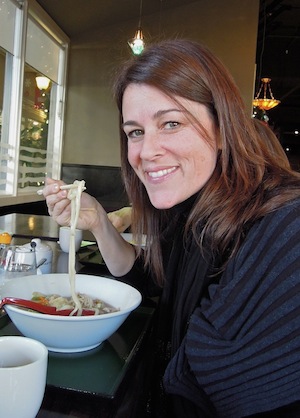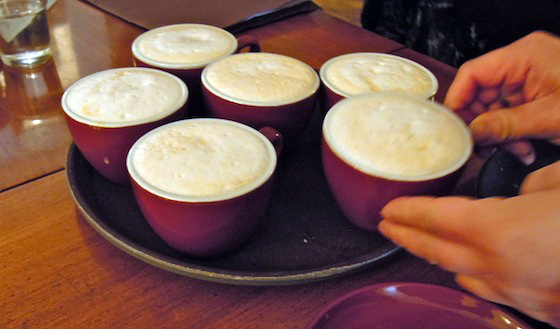
On our walk to our next stop, Lisa gave us a short rundown on the history of Japantown, which began to take shape just after the 1906 earthquake when Japanese San Franciscans needed a place to gather for community support. At its height, it stretched for 36 blocks until WWII internment orders emptied the thriving neighborhood, uprooting its residents and merchants. After the war, many came back to rebuild their lives. In 1968, an urban renewal project bulldozed old Victorians and erected the imposing concrete buildings still at its center, whose fortress-like exterior may seem daunting to uninitiated visitors.
One artifact from the original Japantown that is very much alive is Benkyodo, an unassuming little diner and bakery, that makes traditional fresh mochi confections.
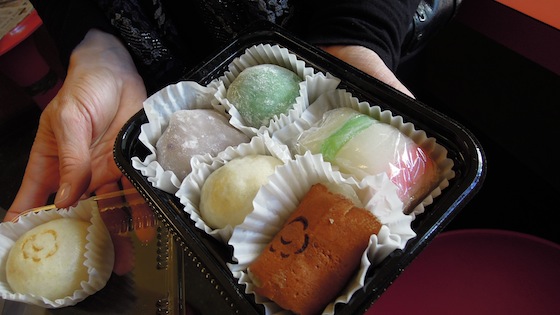
This family business opened in 1906, and is now run by brothers Ricky and Robert Okamura, grandsons of the original owner. Entering their long narrow café, we discovered a split personality: the right side features a low orange Formica counter, matching leatherette bar stools and a Coca Cola menu board with changeable red and black plastic letters that dates from the 50s. Fare and prices also seem to be frozen in time (hot dog $3.15, hamburger $3.10)—just the thing to attract a cadre of regulars. The left side is dominated by the bakery case, which on this late December Friday attracted a crowd of shoppers, standing in line to buy special handmade mochi and manju pastries for the New Year. We sampled chubby, chewy rice flour orbs filled with sweet red beans or blueberries.
Sadly, our next stop was a piece of Japantown history that was just about to close after 105 years in business, Uoki K. Sakai market. There we tasted an earthy hijiki seaweed salad and crunchy burdock and carrot salad from their deli while Lisa clued us in on preparing sushi rice using rice vinegar powder sold at the store. There are two other markets still left in Japantown.
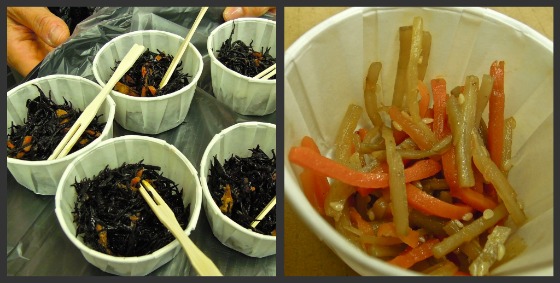
From the oldest businesses, we transitioned to visit the latest addition to Japantown, the New People complex, a narrow, stylish white edifice which houses the SF Film Society, a café and retail stores such as Sou-Sou for tabi (divided shoes and socks) with bold fabric designs and Baby the Stars Shine Bright for Lolita frilly pink dresses.
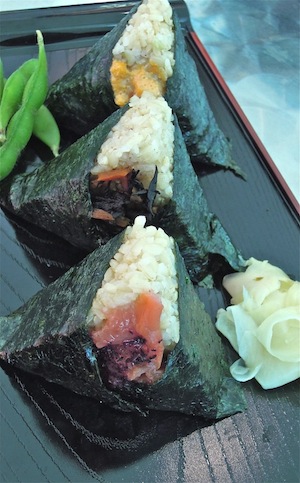 We stopped downstairs at Onigilly for an updated version of the ubiquitous Japanese finger food, onigiri, balls or triangles of white rice wrapped in seaweed, which may be stuffed with pickled plum or cooked salmon. In Japan, these portable meals are sold in train stations, convenience stores and are as much a part of bento lunchboxes as our PB&J sandwiches.
We stopped downstairs at Onigilly for an updated version of the ubiquitous Japanese finger food, onigiri, balls or triangles of white rice wrapped in seaweed, which may be stuffed with pickled plum or cooked salmon. In Japan, these portable meals are sold in train stations, convenience stores and are as much a part of bento lunchboxes as our PB&J sandwiches.
Onigilly (a play the American pronunciation of onigiri) is the creation of Koji Kanematsu, the first male to go through La Cocina’s food business incubator program. He updated the traditional snacks using brown rice and fillings such as eggplant, hijiki and spicy scallop, as well as the traditional pickled plum. Onigilly also operates a food cart in Justin Herman Plaza and other locations around town.
After this substantial snack and a quick tour of the trendy shops in New People, we headed across the street to the Japan Center. As we entered the busy mall, Lisa, an engaging and knowledgeable guide who was inspired by her own cultural curiosity, told us, “You’ll notice we won’t be having any sushi, tempura or teriyaki today. I want to introduce you to new things and demystify some Japanese dishes that might be unfamiliar to you.”
Our eating adventure continued at Mifune Don, where we sat down for another mainstay of real Japanese cooking that is not commonly known to foreigners. Okonomiyaki is called a “savory pancake” but the name literally means “what you like” and is a tasty way to use leftovers. These large grilled discs usually contain some combination of eggs, shredded yam, cabbage, meat, or seafood, topped with a special brown sauce and squiggles of Japanese mayonnaise. They are sprinkled with bonita shavings, whose eerie 3-D undulations seemed to be waving at me, inviting me to partake in this hearty, vegetable griddlecake. My first okonomiyaki was a satisfying discovery and definitely will not be my last.

Then our group of locals and out of state visitors shifted into an intense assault on sweetness, starting with a neon-hued, mini Geisha float—green tea ice cream topped with red beans, green tea syrup and red mochi cubes at Carol Murata’s Café Hana.
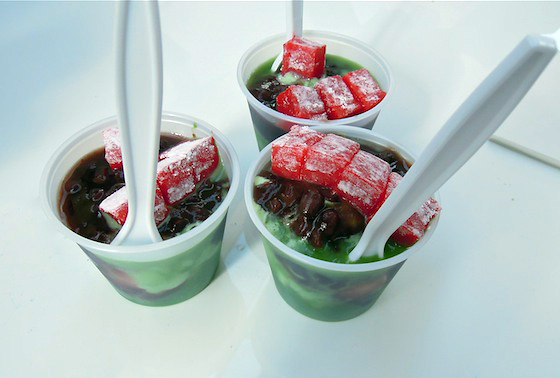
For our second dessert, we strolled over to May’s Coffee Shop, run by Carol’s mother May Murata since 1973, to sample taiyaki, a fish-shaped sweet with a long history. In Japanese culture, the sea bream is considered a symbol of good luck and these distinctively shaped pastries are made by pouring waffle-like batter into metal molded trays and topping with red beans, chocolate or other fillings. The two halves of the fish are then folded together and cooked until golden brown. They originated in Tokyo in 1909.
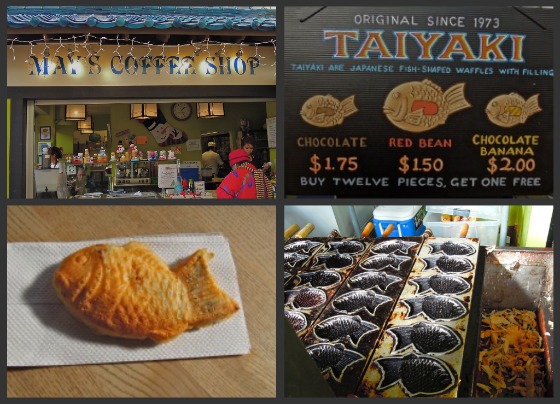
Full of lucky fish pastries, we ducked into Nippon-Ya, a stylish shop specializing in omiyage, the artfully wrapped regional specialties that Japanese visitors commonly bring back from their travels for friends and co-workers. Beautifully boxed mochi in fruit flavors, plus cookies, tea and other souvenirs from all over Japan are their most popular selections. We were offered tastes of creamy chocolate mochi.
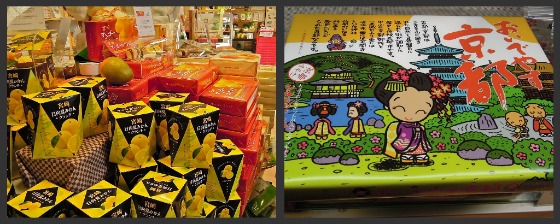
On our way out of the building Lisa pointed out shops that carry stickers, stationery and fashion and then impossibly announced that it was time for lunch. A 3-course lunch at that, with wakame, a slippery green seaweed salad, a pair of mini gyozas and a big bowl of steaming nabeyaki noodle soup with vegetables, fish cake, chicken, shrimp tempura and udon or soba noodles. The key ingredient of the soup is the dashi flavored broth and Mifune Bistro’s dashi had a strong, clear taste.
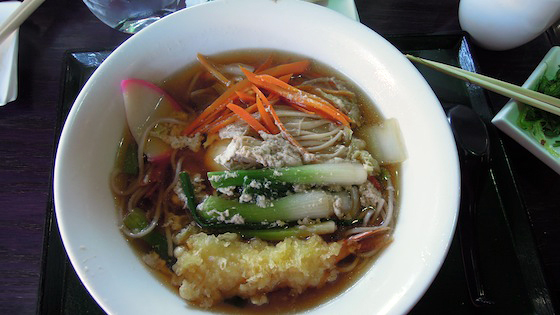
As I waddled out after lunch, much wiser and definitely much fuller than before I started the tour, I made mental note of the dozen new tastes I’d sampled, and wondered if this is how sumo wrestlers begin to build their girth.
